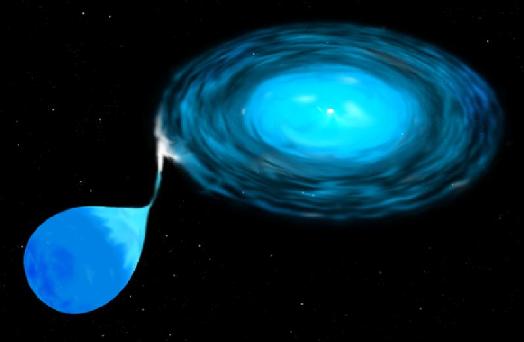
(what's wrong with this picture?)
Many WDs live in binary systems (ie, Sirius B). The
stars in binary systems will evolve at different rates if they have different
masses, so often we have binaries with a WD and a main sequence star (again,
like Sirius B). What happens when the main
sequence star starts evolving?
As the MS star evolves, some of its mass can be transferred onto the white dwarf:

(what's wrong with this picture?)
So fresh hydrogen (and helium) is added to the white dwarf.
Interesting things can now happen!
As hydrogen is added to the white dwarf, we get a layer of hydrogen on top of the C/O white dwarf. As more and more H is added, the H at the bottom of the layer is squeezed more and more (strong gravity: M/R2), its temperature and density rise, and it becomes degenerate. Eventually conditions become extreme enough that hydrogen burning can begin. Think: what happens when nuclear burning occurs in degenerate matter?Novae: the energy released blasts off the hydrogen layer, and the nova shines with luminosity of 105 Lsun (10-12 magnitudes brighter than normal), fading over a few hundred days. Eventually mass transfer begins again, and the WD may be ready to go nova again in 104-105 years.
These events are much more common than massive star "Type II" supernovae. Why?
If the mass transfer rate is high, the WD grows greatly in mass. When the mass exceeds 1.3Msun, nuclear carbon burning can begin in the degenerate core -- since it is degenerate, the core heats up but does not expand. When half of the C/O core has been turned into Iron, enough energy is released to remove degeneracy and the WD rapidly expands -- ie, it blows up. KABOOM!Unlike a nova, a Type Ia supernova destroys the WD, and it is extremely luminous (L > 109 Lsun), even brighter than a Type II supernova.
Notes:
- Most Iron in the universe is thought to come from Type Ia (not Type II) supernovae. Why?
- The critical mass is LESS than the Chandrasekhar Limit.